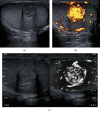Multiparametric Ultrasound (mpUS) of a Rare Testicular Capillary Hemangioma
- PMID: 31956462
- PMCID: PMC6949659
- DOI: 10.1155/2019/7568098
Multiparametric Ultrasound (mpUS) of a Rare Testicular Capillary Hemangioma
Abstract
Capillary hemangioma is a rare entity among testicular tumors. We demonstrate the case of an 18-year-old patient with palpatoric and sonographic conspicuous left testicle and negative serum tumor markers (α-fetoprotein, β-human chorionic gonadotropin, and lactate dehydrogenase). Ultrasound (US) imaging represented an isoechogenic lesion with high vascularization in both power Doppler and microflow imaging with central feeding artery. Both strain elastography and shear wave elastography demonstrated a stiff lesion compared to surrounding testicular tissue. While contrast-enhanced ultrasound (CEUS) clearly depicted high vascular load, time intensity curve (TIC) analysis was able to show shorter median transit time, higher peak enhancement, and higher wash-in area under the curve compared to regular testicular tissue. Histopathological examination revealed a lobular constructed and rich vascularized proliferation without cellular atypia and feeder vessels with positive reaction to CD34, CD31, CD99, and Vimentin. Proliferative activity was quantified to 3-5% by Ki-67 index. Two days after surgery, the patient could leave the hospital in subjective wellbeing. While histology remains the gold standard to make a precise diagnosis of capillary hemangiomas due to small case numbers and variety of this benign tumor, the combination of multiparametric US and clinical information may be a promising future tool in preoperative assessment.
Copyright © 2019 Paul Spiesecke et al.
Conflict of interest statement
None of the authors reports a relationship with industry and other relevant entities—financial or otherwise—that might pose a conflict of interest in connection with the submitted article.
Figures




References
-
- Lock G., Schröder C., Schmidt C., Anheuser P., Loening T., Dieckmann K. Contrast-enhanced ultrasound and real-time elastography for the diagnosis of benign Leydig cell tumors of the testis – a single center report on 13 cases. Ultraschall in der Medizin - European Journal of Ultrasound. 2014;35(06):534–539. doi: 10.1055/s-0034-1385038. - DOI - PubMed
Publication types
LinkOut - more resources
Full Text Sources

